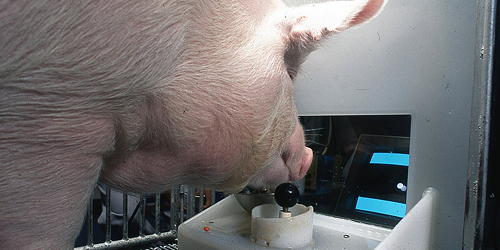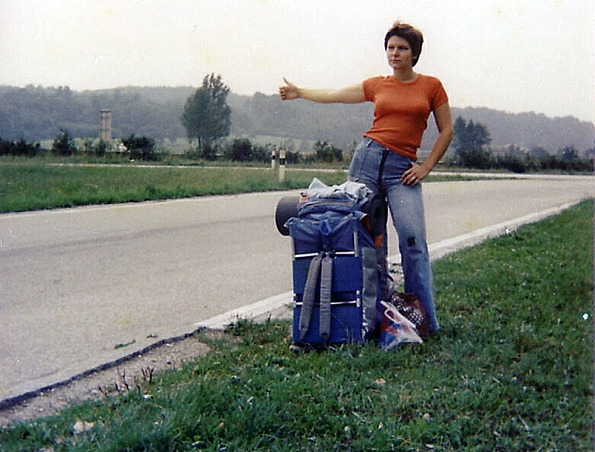Experiments
Buried Alive Experiment
1926: French journalist Paul Heuzé sealed himself in an air-tight coffin to investigate how fakirs performed this feat. He lasted one hour and fifteen minutes before signalling that he needed to be let out.More info about Heuzé at Wikipedia.

Illustrated London News - Dec 11, 1926

East Liverpool Evening Review - Dec 23, 1926
Posted By: Alex - Mon May 10, 2021 -
Comments (3)
Category: Experiments, 1920s
Pigs Play Video Games
Researchers at Pennsylvania State University recently succeeded in teaching four pigs how to play a video game. Admittedly, the game was pretty simple. The pigs had to use a joystick to move a cursor toward a target wall on the computer screen. If they hit the wall, they'd hear a "bloop" and then get a food reward.The pigs performed at a level far above random chance. However, the researchers noted that their skill level was below that of non-human primates. The scientists speculated that this may have been because it was difficult for the pigs to manipulate the joystick with their snout. Or perhaps it was because all four pigs were far-sighted and "despite attempts to position the computer monitor appropriately, it is impossible to know how well the pigs were able to see, and subsequently correctly discriminate between targets."
More info: Lab Manager, Frontiers in Psychology

Thanks to Gerald Sacks!
Posted By: Alex - Wed Feb 17, 2021 -
Comments (1)
Category: Animals, Experiments, Videogames and Gamers
Upside-Down Rhinos
Recent research has proven that it's safe to hang rhinos upside-down by their feet for up to ten minutes. Future research should let us know whether longer periods, up to half-an-hour, are also safe.More info: Cornell Chronicle, Journal of Wildlife Diseases

Posted By: Alex - Mon Feb 08, 2021 -
Comments (6)
Category: Animals, Experiments
The Shipwreck Diet
Studies conducted by the U.S. Army in the late 1940s sought to determine the minimum amount of food a person would need to survive if they were shipwrecked on a desert island.One of the oddities the researchers discovered was that if, for some reason, the shipwrecked person had to choose between steak and water, they should choose the water: "Protein has the effect of drying up the body. Therefore eating a steak on a desert island with little or no water available would probably be worse than eating nothing, depending upon how long rescue took."

"Shipwreck Diet: One of eleven Army volunteers who for six weeks will live on biscuits and water at the Metropolitan Hospital, New York City, to determine a human survival ration."
Newsweek - Mar 15, 1948


Waterloo Courier - Nov 16, 1949
Posted By: Alex - Mon Nov 16, 2020 -
Comments (4)
Category: Food, Nutrition, Experiments, 1940s, Dieting and Weight Loss
St. Louis Heat Experiment
Google Arts & Culture hosts a series of images showing a bizarre-looking experiment conducted at the St. Louis University Medical School in 1956. The photos were taken by Life photographer Albert Fenn.Google offers no more details about the photos, but some searching reveals the same photos on Getty Images where they're identified as "an experiment about the effects of heat on a body during highspeed jet flight."
Who the researcher was, I don't know.





Posted By: Alex - Wed Oct 21, 2020 -
Comments (0)
Category: Experiments, 1950s
Farting in an operating room
If someone farts in an operating room, will he/she contaminate the room with germs? Dr. Karl Kruszelnicki and microbiologist Luke Tennent of Australia together devised an experiment to find out:Another source (below) claims that the 'colleague' who supplied the farts was, in fact, an eight-year-old boy:

Sydney Morning Herald - July 16, 2001
Incidentally, Dr. Kruszelnicki has been mentioned before on WU. See 'falling cats'.
Posted By: Alex - Tue Jul 28, 2020 -
Comments (5)
Category: Hygiene, Flatulence, Experiments
Sugar Doping
1924: Despite being fed sweet hot tea and peppermint creams in an experimental attempt to increase their energy, the Yale soccer team lost to the visiting team by 5 to 1.
Bridgeport Telegram - Nov 11, 1924
Posted By: Alex - Wed Jun 10, 2020 -
Comments (0)
Category: Sports, Experiments, Junk Food, Nutrition, 1920s
Staring Hitchhikers
Will hitchhikers get more rides if they stare at oncoming drivers or if they look away? A 1974 study published in the Journal of Applied Social Psychology attempted to answer this question:In the stare conditions, E stared at the driver of the target vehicle and attempted to fixate on the driver's gaze and maintain this gaze as long as possible until the driver either stopped his vehicle or drove on. In the comparison conditions, E looked anywhere else but at the driver. Thus, on some trials E looked in the general direction of the car; on other trials E looked at his feet, the road, the sky, etc. Es were specifically instructed to neither smile nor frown, and to maintain a casual (neither rigid nor slouching) body postural orientation while soliciting rides.
The two hitchhikers were described as, "both 20 years of age and both dressed in bluejeans and dark coats. The male had short, curly blond hair, and the female, straight, shoulder length blond hair. Both could be described as neat, collegiate, attractive in physical appearance, and of an appropriate age to be hitchhiking."

A hitchhiker in Luxembourg - Aug 1977 (source: wiktionary.org)
(not one of the hitchhikers in the study)
Staring is often interpreted as a threat. So the researchers anticipated that staring at oncoming drivers might result in fewer rides. But the opposite turned out to be true. Which is a useful tip to know if you ever need to hitchhike. But what really helped get a lot of rides was being a single female. From the study:
Contrary to popular belief and hitchhiking folklore , it was no easier for a male-female couple to hitch a ride than a single male, and a mixed sex couple was less successful at soliciting rides than a single female hitchhiker. Although the generality of this conclusion is limited by the fact that it is based upon results obtained by one male and one female E, it is probably the case that couples are less successful hitching rides because of space limitations in the cars they approach. That is, it is more likely that the driver will have room for one additional passenger than that he will have room for two or more additional passengers in his car.
Incidentally, the experimenters never actually ever got in a car with anyone: "After a motorist stopped to pick up one of the hitchhikers, he was politely thanked and given a printed description of the nature of the experiment. No driver expressed any discomfort when he learned that the hitchhiker did not actually want a ride."
Posted By: Alex - Mon May 04, 2020 -
Comments (5)
Category: Science, Experiments, Psychology, 1970s, Cars
Can fear cure cancer?
In 1962, East German researchers conducted a bizarre medical experiment in an attempt to find out if fear could cure cancer. They inoculated some "mice, rabbits, rats, and cocks" with cancer cells. Then they put these animals into a cage which they lowered "into a zoo-like enclosure where 30 ravenous African polecats paced for food. The polecats would leap upon the little cage, shrieking and clawing at their hoped-for prey." This terror experience was repeated every two hours for several days.The result: the cancer cells grew more slowly in the terrorized animals.
Of course, this begs the question, what it is about fear that would fight cancer? Was it the elevated adrenalin levels? Or was there some other biochemical change that caused the effect?
Unfortunately, I can’t find any other details about this unusual experiment except for the brief news report below. I'm assuming there was never a human version of the experiment. Though one never knows, given some of the other stuff that researchers got up to behind the Iron Curtain.

The Paterson News - Nov 7, 1962
Posted By: Alex - Fri Mar 27, 2020 -
Comments (0)
Category: Medicine, Science, Experiments, 1960s
Chewing Gum Stigma
In Oct 2013, the chewing gum company Beldent gathered five sets of identical twins. In each set, one twin was instructed to chew gum while the other sat motionless. Visitors to the Buenos Aires Museum of Contemporary Art were then asked questions about the twins.Their answers indicated that 73 percent of people had a more favorable impression of the gum chewing twins. Beldent claimed that this disproved the "chewing gum stigma."
Though I disagree. I think gum chewing does turn off some people. What the experiment showed was that there's an even greater stigma attached to being expressionless, showing no emotion at all
Posted By: Alex - Tue Dec 03, 2019 -
Comments (0)
Category: Experiments, Psychology, Candy

| Who We Are |
|---|
| Alex Boese Alex is the creator and curator of the Museum of Hoaxes. He's also the author of various weird, non-fiction, science-themed books such as Elephants on Acid and Psychedelic Apes. Paul Di Filippo Paul has been paid to put weird ideas into fictional form for over thirty years, in his career as a noted science fiction writer. He has recently begun blogging on many curious topics with three fellow writers at The Inferior 4+1. Contact Us |




